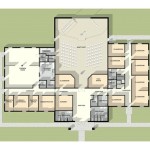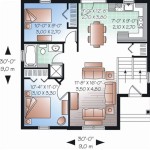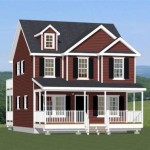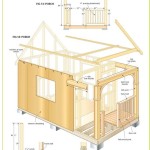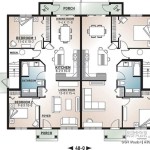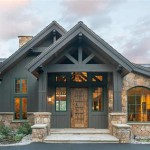Open Floor Plan House Designs: Exploring Space, Light, and Functionality
Open floor plan house designs have gained significant popularity in recent decades, transforming how living spaces are conceived and utilized. Characterized by the minimization of interior walls, these designs create a seamless flow between living, dining, and kitchen areas, fostering a sense of spaciousness and promoting social interaction within the home. While the appeal of open floor plans is undeniable, a thorough understanding of their advantages, disadvantages, and design considerations is crucial for homeowners contemplating this architectural style.
The essence of an open floor plan lies in the deliberate reduction of physical barriers. Traditional layouts often compartmentalize rooms, assigning distinct functions to each enclosed space. In contrast, open floor plans prioritize visual connectivity and spatial continuity. This typically involves removing or minimizing walls between the main living areas, allowing natural light to penetrate deeper into the home and creating a more expansive and airy ambiance. The appeal extends beyond aesthetics, influencing everyday living and social dynamics within the household.
Enhanced Natural Light and Spaciousness
One of the most significant benefits of open floor plan designs is the maximization of natural light penetration. With fewer walls obstructing the diffusion of sunlight, natural light can illuminate a larger area, reducing the need for artificial lighting during the day. This increased natural light contributes to a brighter and more uplifting atmosphere, improving mood and overall well-being. Furthermore, the absence of walls creates a sense of spaciousness, making even smaller homes feel larger and more inviting. This expansive feeling is particularly advantageous in urban settings where space may be limited.
The strategic placement of windows and doors in an open floor plan is paramount to optimizing natural light. Large windows and sliding glass doors can be incorporated to capture sunlight from multiple angles. Consider the orientation of the house to maximize sunlight exposure throughout the day. South-facing windows, for instance, receive the most direct sunlight during the winter months, while east-facing windows capture the morning sun. The selection of window treatments can also significantly impact the control and diffusion of natural light within the open space.
Beyond natural light, the spaciousness of an open floor plan offers tangible benefits. A larger, connected space can be more easily adapted to different needs and activities. It provides ample room for entertaining guests, accommodating family gatherings, and engaging in collaborative projects. The lack of physical barriers encourages interaction and communication among family members, fostering a stronger sense of togetherness. Moreover, the open layout can be particularly advantageous for individuals with mobility challenges, providing greater ease of movement and accessibility throughout the living area.
Promoting Social Interaction and Family Connectivity
Open floor plans are inherently designed to facilitate social interaction and family connectivity. The absence of walls between the living, dining, and kitchen areas allows individuals to remain connected while engaging in different activities. A parent preparing a meal in the kitchen can easily supervise children playing in the living area, or family members can converse and interact while pursuing their individual interests. This sense of interconnectedness strengthens family bonds and promotes a more collaborative living environment.
Open floor plans are particularly well-suited for entertaining guests. The seamless flow between the living, dining, and kitchen areas allows hosts to remain engaged with their guests while preparing food or drinks. Guests can easily move between different areas of the home, fostering a more relaxed and inclusive atmosphere. The spaciousness of the open layout also provides ample room for large gatherings, making it ideal for hosting parties and celebrations. The layout can also be easily adapted for various types of events, ranging from casual get-togethers to formal dinner parties.
The ability to maintain visual contact and engage in conversation across different areas of the home promotes a sense of unity and shared experience. The open layout eliminates the feeling of isolation that can occur in traditional layouts with compartmentalized rooms. Family members are more likely to interact with one another, share experiences, and participate in joint activities. This increased interaction can strengthen relationships, improve communication, and foster a more supportive and collaborative family environment. The open layout also encourages spontaneous interactions and informal gatherings, creating a more dynamic and vibrant living space.
Challenges and Design Considerations
While open floor plans offer numerous advantages, they also present certain challenges that must be carefully considered during the design process. Noise control, lack of privacy, and potential for visual clutter are among the primary concerns that homeowners should address. Effective space planning, strategic use of furniture, and incorporation of sound-absorbing materials are essential for mitigating these challenges and creating a comfortable and functional open living space.
Noise control can be a significant issue in open floor plans, as sound can travel freely throughout the interconnected spaces. To address this, consider incorporating sound-absorbing materials such as carpets, rugs, upholstered furniture, and acoustic panels. These materials can help to dampen sound and reduce echoes, creating a more peaceful and relaxing environment. Strategic placement of furniture can also help to create sound barriers, such as using a large sofa or bookshelf to separate the living area from the dining area. The choice of flooring materials can also impact noise levels, with softer materials like carpet being more effective at absorbing sound than hard surfaces like tile or wood.
The lack of privacy can be another concern in open floor plans, particularly for individuals who value personal space and solitude. To mitigate this, consider incorporating designated quiet zones within the open space, such as a reading nook or a study area. These areas can be separated from the main living area by strategically placed furniture, screens, or partial walls. The use of curtains or blinds can also provide privacy when needed. Careful consideration of the layout and furniture placement can help to create a sense of privacy without compromising the open and airy feel of the space.
Visual clutter can easily accumulate in open floor plans, making the space feel disorganized and overwhelming. To combat this, implement effective storage solutions and maintain a minimalist approach to decor. Built-in shelving, cabinets, and drawers can provide ample storage space for concealing clutter. Choose furniture with clean lines and simple designs, and avoid overcrowding the space with unnecessary items. Regular decluttering and organization are essential for maintaining a visually appealing and functional open floor plan. Consider incorporating designated storage areas for specific items, such as toys, books, or electronic devices. Using baskets, bins, and other organizational tools can help to keep clutter under control and maintain a sense of order.
In addition to these specific challenges, there are other design considerations that must be addressed when planning an open floor plan. Ventilation is crucial to ensure proper air circulation throughout the interconnected spaces. The location and size of windows and doors should be carefully considered to maximize natural ventilation. The use of ceiling fans or a whole-house ventilation system can also help to improve air circulation. Furthermore, consider the flow of traffic through the open space to ensure that it is both functional and aesthetically pleasing. The placement of furniture and the arrangement of different activity zones should be carefully planned to create a comfortable and inviting living environment.
Ultimately, the success of an open floor plan depends on careful planning, thoughtful design, and a clear understanding of the homeowner's individual needs and preferences. By addressing the potential challenges and embracing the opportunities that this architectural style offers, homeowners can create a living space that is both beautiful and functional, fostering social interaction, promoting family connectivity, and enhancing the overall quality of life.

Free Editable Open Floor Plans Edrawmax

Classic House Plans Open Floor Concept

10 Small House Plans With Open Floor Blog Homeplans Com

Open Floor Plans Build A Home With Smart Layout Blog Dreamhomesource Com
:max_bytes(150000):strip_icc()/1660-Union-Church-Rd-Watkinsville-Ga-Real-Estate-Photography-Mouve-Media-Web-9-77b64e3a6fde4361833f0234ba491e29.jpg?strip=all)
18 Open Floor House Plans Built For Entertaining

Modern Open Floor House Plans Blog Eplans Com

House Design Trends What S Popular In Cur Floor Plans Extra Space Storage

Open Floor Plans Creating A Breathable Livable Custom Home Builders Schumacher Homes

Free Editable Open Floor Plans Edrawmax

Pros And Cons Of An Open Concept Floor Plan Generation Homes Nw


